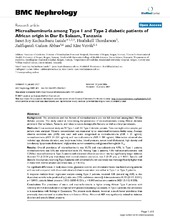| dc.description.abstract | Background: The prevalences and risk factors of microalbuminuria are not full described among black African diabetic patients. This study aimed at determining the prevalence of microalbuminuria among African diabetes patients in Dar es Salaam, Tanzania, and relate to socio-demographic features as well as clinical parameters. Methods: Cross sectional study on 91 Type 1 and 153 Type 2 diabetic patients. Two overnight urine samples per patient were analysed. Albumin concentration was measured by an automated immunoturbidity assay. Average albumin excretion rate (AER) was used and were categorised as normalbuminuria (AER < 20 ug/min), microalbuminuria (AER 20–200 ug/min), and macroalbuminuria (AER > 200 ug/min). Information obtained also included age, diabetes duration, sex, body mass index, blood pressure, serum total cholesterol, high-density and low-density lipoprotein cholesterol, triglycerides, serum creatinine, and glycated hemoglobin A1c. Results: Overall prevalence of microalbuminuria was 10.7% and macroalbuminuria 4.9%. In Type 1 patients microalbuminuria was 12% and macroalbuminuria 1%. Among Type 2 patients, 9.8% had microalbuminuria, and 7.2% had macroalbuminuria. Type 2 patients with abnormal albumin excretion rate had significantly longer diabetes duration 7.5 (0.2–24 yrs) than those with normal albumin excretion rate 3 (0–25 yrs), p < 0.001. Systolic and diastolic blood pressure among Type 2 patients with abnormal albumin excretion rate were significantly higher than in those with normal albumin excretion rate, (p < 0.001). No significant differences in body mass index, glycaemic control, and cholesterol levels was found among patients with normal compared with those with elevated albumin excretion rate either in Type 1 or Type 2 patients. A stepwise multiple linear regression analysis among Type 2 patients, revealed AER (natural log AER) as the dependent variable to be predicted by [odds ratio (95% confidence interval)] diabetes duration 0.090 (0.049, 0.131), p < 0.0001, systolic blood pressure 0.012 (0.003–0.021), p < 0.010 and serum creatinine 0.021 (0.012, 0.030). Conclusion: The prevalence of micro and macroalbuminuria is higher among African Type 1 patients with relatively short diabetes duration compared with prevalences among Caucasians. In Type 2 patients, the prevalence is in accordance with findings in Caucasians. The present study detects, however, a much lower prevalence than previously demonstrated in studies from sub-Saharan Africa. Abnormal AER was significantly related to diabetes duration and systolic blood pressure. | en_US |

